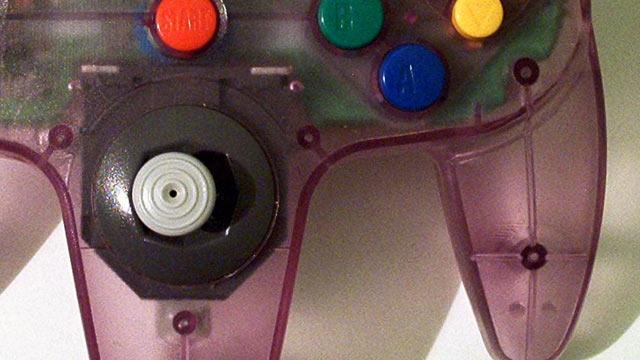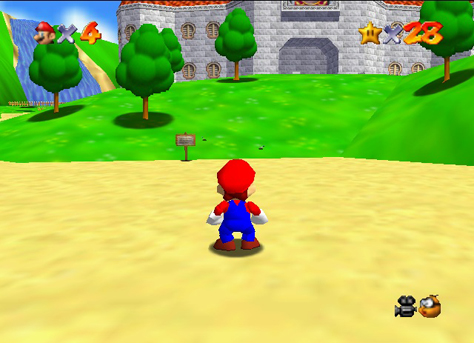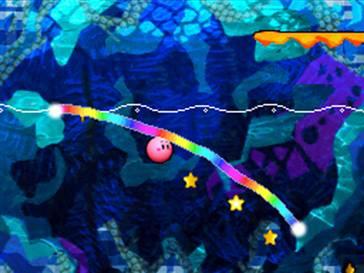
This article was originally published on April 5, 2011.
It seems as though whenever Nintendo releases a new controller, it effectively sets the standard for all other controllers to follow, with one or more new features instantly rendering every older controller inadequate. NES gave the world the D-Pad, SNES added shoulder buttons and introduced the four face buttons we all know and love, and Nintendo 64 gave gaming one of the biggest leaps in controller design ever, the analog stick. Sure, other systems were doing 3D environments before N64. Sega had the Saturn and Sony’s PlayStation was building well on its way to the massive success it would become, but neither had the analog stick, a simple enough device that quickly established itself as the only real way to control games that went beyond the 2D planes of old. Naturally, it didn’t take too long for the other guys to embrace the stick themselves.
Using sticks to control your characters was nothing new back in the N64 days, in fact, it was quite old school. At first glance, the joysticks on old Atari and arcade systems might seem like they beat Nintendo to the punch, but while they look similar, the mechanics are drastically different. Joysticks had more in common with the D-Pad, as they offered eight directions at a constant sensitivity (aka digital control) despite the fact that the sticks themselves had full range of movement. Analog sticks are just that: analog, meaning they provide 360 degree movement and are sensitive to the degree of how far the stick is being pushed. These features are what made running around in early N64 games like Mario 64 such a revelatory experience: you could creep, walk or run in every possible direction.
While plenty of our readers probably remember their first jaunts through 3D worlds just like me, I’m willing to bet that more than a few of our readers grew up with N64 or GameCube as their first system, meaning they were born into a world of analog controls. To put this into perspective for you youngsters, the SNES to N64 transition was perhaps more significant than the introduction of motion controls. Not only was there the introduction of a paradigm shifting gameplay mechanic, but also the introduction of fully realized 3D worlds, which is perhaps the biggest step forward since the genesis of gaming. These two features were hugely significant, and each is what made the other possible.

Unlike my first steps as a baby, I can remember my first steps in a 3D world
Of course, we all know the outcome of the 32/64 bit generation. PlayStation ultimately took a commanding lead that wouldn’t waver until this generation. One reason for this was of course the use of CD media, a larger, cheaper storage medium than cartridges that made PlayStation an easier and profitable system to develop for that also had enough space to fit the pretty cut scenes that made for really epic commercials and trailers. The other reason was how quickly and effectively Sony was able to churn out its own analog stick controller, the Dual Shock. Of course, Sony’s new controller added a few new features of its own, such as a second stick, clickable buttons under each stick, and a built in rumble system which was a lighter, more convenient copy of Nintendo’s add on Rumble Pack. Another major advantage for Sony’s controller was its more ergonomic shape, which itself was based heavily on the SNES controller.
Surprisingly, it wouldn’t be until the next generation that the introduction of dual analog sticks would truly be taken advantage of, and it would take a newcomer to the console wars to do it. Microsoft’s Xbox went with the dual stick setup, as did Nintendo, but even though its first controller design was a massive, heavy, uncomfortable black mass that could have been mistaken for a medieval flail, it did come up with one concept that made millions of gamers suffer through its terrible design. Halo was the one reason people shelled out money for Microsoft’s system at launch because it was the first console game to really do the FPS genre justice. Yes, GoldenEye and Perfect Dark were great games at the time, but time has not treated them well compared to the dual analog design established by the folks at Microsoft and Bungie. The second stick allowed for developers to map it like a mouse in a PC shooter, so looking about and aiming became a much smoother, easier process than systems introduced in earlier console attempts at the genre, and the shoulder buttons, another Nintendo innovation, made perfect triggers. Third person games primarily used the stick as a much more effective means of camera control, but its implication for the FPS genre ultimately proved more significant as it grew in popularity year over year to become the prominent choice for the core gaming crowd.
Nintendo, of course, also went with the dual analog design with the GameCube controller, but it went with with a stubbier design for its second “C” stick that displeased the millions who had grown accustomed to the PlayStation design. As shooters took off in popularity and PlayStation and Xbox supported online play, Nintendo was left in the dust with an unpopular controller, severely limited online abilities, and a library of titles that lacked the same level of appeal to the core gaming crowd. In order to make a comeback, it seemed as though Nintendo would have to rally its efforts and beat Sony and Microsoft at their own game by doing everything they could to appeal to the changing tastes of the gaming world, so naturally they did completely the opposite, ignoring pretty much everything that allowed Sony and Microsoft to push in on the industry Nintendo once dominated. One of the first things to go on Nintendo’s new road to success was actually the analog stick.
The first step in Nintendo’s transformation was DS, a quirky new handheld that was only a fraction as powerful as Sony’s upcoming PlayStation Portable and was completely stick-less to boot. But DS was cheap, it had great battery life, and most importantly, it had two screens with one of them being touch sensitive. Power-wise, it was a bit more powerful than N64, and a few early attempts to port N64 mainstays like Mario 64 and Rayman 2 were decent enough, but ultimately suffered from the attempts to utilize a virtual analog stick on the touch screen rather than the real deal. Instead of simply trying to have this suffice, Nintendo and many other developers simply went wild with a torrent of new and fresh ideas made possible by the touch screen and dual displays. These new ideas didn’t always resonate with gamers who had embraced Sony and Xbox, but the idea of petting a virtual puppy with a stylus appealed to a much larger crowd of people who had no interest in shooting virtual aliens.

Kirby says, “Buttons are for losers!”
For the next round of consoles, Nintendo once again eschewed the norm by introducing the motion sensitive Wii Remote, another stick-less device that required a completely separate attachment for even one stick. The controller’s abilities as a pointer largely supplanted the need for a second analog stick in many titles, while other genres, old and new, adapted to the new controller. This once again made room for a slew of new gamers who were much more interested in the new concepts than the traditional offerings from Sony and Microsoft. However, it remained another major shift that once again proved analog sticks surprisingly unnecessary.
Over the past few years, Nintendo has been on something of a nostalgia streak with games like New Super Mario Bros. Wii, Donkey Kong Country Returns, Metroid: Other M and Kirby’s Epic Yarn, all titles from classic franchises that stick to very old school sensibilities that not only do completely without analog sticks, but also largely ignore many of Wii’s signature features. 2D platformers largely faded into obscurity after the world got its first taste of 3D, but all of a sudden their straightforward simplicity, often combined with surprisingly difficult level design, have once again proven quite appealing to longtime and newer gamers alike.
In keeping with tradition, the other console manufacturers have been inspired by Nintendo’s innovations. Sony has released Move for PS3, which is pretty much a carbon copy of the Wii Remote, and Microsoft has completely discarded the physical interface with Kinect, a motion sensing, voice- and face-recognizing camera controller that has proven incredibly successful in spite of the skeptical reception it received from more than a few jaded gamers, myself included. Furthermore, smart phones have turned into quite popular gaming platforms that rely entirely on touch controls and cheap, accessible software.
Regardless, the analog stick and the buttons it hangs around with are far from dead and gone. The core gamer is still interested in the more complex experiences that touch and motion sensing alternatives simply can’t accommodate yet. 3DS added an analog stick to its controls to better satisfy this audience, and the PSP follow up has also added an analog stick, bringing its total to two, the amount necessary to excel in the FPS market that still remains the backbone of the industry.
Today the analog stick has settled down into its place as just another input among many: an important piece of the gaming experience that isn’t completely necessary for every game out there. Touch screens and motion controls have taken over as the keys to evolving gaming as we know it, but one day, they, too, will become a normal, expected part of every gaming interface and something new will take their place.




 ShareThis
ShareThis







I think the analog stick is here to stay. Touch screens and motion controls are cool and all, there are some game genres that are really hard to replicate on those control options (fighting games and retro shoot ’em ups just to name a few).
Remember on Nintendo 64 how many games had challenges that forced you to use the analog input of the joystick? Mario 64 and Banjo-Tooie had parts where you had to sneak slowly to progress. And Pokémon Stadium had the Ekans minigame where how gently you flicked the stick affected your aim. It was like “hey, look at this new stick! You have to use its new analog control to get past this challenge!”
This sort of happens with every new control input, doesn’t it? At first they throw in little flourishes or gimmicks just to show off the technology, before it becomes pretty standard. Wii definitely had a lot of unnecessary motion gestures at times… Then at some point games come along that really justify the input. (Canvas Curse for stylus, Skyward Sword for motion, etc.)
I can’t remember the last time I was required to gently nudge the analog stick in a game… Actually wait, yes I can. You have to creep quietly in Alpha Sapphire/Omega Ruby to catch Pokemon with the NavDex.